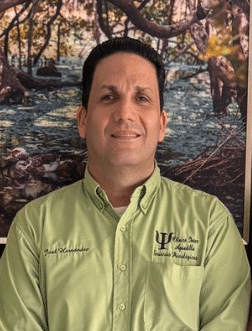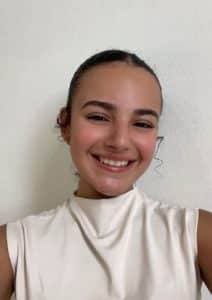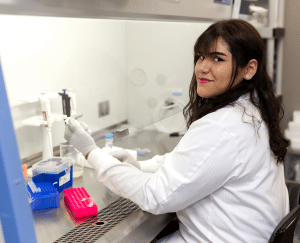- (787)891-0925 Ext. 2700
- info@aguadilla.inter.edu
Melody Soto Vargas es estudiante del programa de Maestría en Biotecnología Molecular en la Universidad Interamericana de Puerto Rico, Recinto de Aguadilla. Sus objetivos a largo plazo incluyen convertirse en Physician Scientist o realizar un doctorado en Genética, con el fin de contribuir al desarrollo de terapias innovadoras desde la investigación. Participará en el simposio con una presentación tipo afiche. El título de su presentación es “Edición genética de células T con CRISPR-Cas9 en inmunoterapia para cáncer de ovario”. Su participación destaca su compromiso con la investigación en el área de biotecnología molecular aplicada a la inmunoterapia.
Eliezer Meléndez González es estudiante del programa de Maestría en Biología con especialidad en Biotecnología Molecular. Su objetivo a largo plazo es continuar desarrollándose integralmente como persona, combinando su crecimiento personal con su formación científica. Participará en el simposio con una presentación tipo afiche. El título de su presentación es «Aumentando la conversión de tioles 3MH y 4MMP en Saccharomyces cerevisiae para la Enología». Su participación destaca su compromiso con la investigación en el área de biotecnología aplicada a la ciencia de los alimentos y bebidas fermentadas.
Ennovy R. Bravo es estudiante del programa de Maestría en Biotecnología Molecular. Su objetivo profesional a largo plazo es ingresar a la escuela de medicina veterinaria y contribuir al campo mediante la investigación y el cuidado clínico de animales, con un enfoque en la conservación y la salud animal. Participará en el simposio con una presentación tipo afiche. El título de su presentación es «Exploring the Genetic and Morphological Diversity of Tardigrades in Puerto Rico». Su participación destaca su compromiso con la investigación en el área de Biología Molecular y Diversidad Genética.
Pamela N. Sánchez Ortiz es estudiante del programa de Consejería Psicológica con especialidad en familia en la Universidad Interamericana de Puerto Rico, Recinto de Aguadilla. Entre sus objetivos a corto y largo plazo se encuentra la obtención de la licencia para la práctica de la psicología, lo que le permitirá aplicar sus conocimientos de manera profesional y contribuir activamente al bienestar de las personas y familias. Además, busca continuar su desarrollo en el campo de la psicología a través de certificaciones especializadas en arte terapia y trauma, con la intención de integrar enfoques creativos y terapéuticos en el manejo emocional y la promoción de la resiliencia psicológica. A futuro, aspira a realizar un doctorado en Psicología Clínica. El título de su afiche es «Edadismo: Percepción de los adultos mayores sobre el discrimen por edad», y su presentación pretende aportar a la comprensión de los desafíos que enfrenta este grupo poblacional, promoviendo una visión más inclusiva y respetuosa hacia la vejez.

Objetivos a largo plazo: La meta es establecer una clínica psicológica contará con programas de mediación familiar que incluyan consejería psicológica para individuos, parejas y familias, así como servicios de apoyo emocional y social. El propósito es brindar atención , fomentando el bienestar psicológico de la comunidad y proporcionando un acceso centralizado a diversos servicios especializados.
Título de la presentación: Los desafíos que enfrentan los docentes universitarios al enseñar estudiantes con diversidad funcional

Metas a largo plazo: Luego de completar la maestría el objetivo es pasar la reválida y obtener la licencia para comenzar a ejercer la profesión y trabajar con todo tipo de población. Sin embargo, no descarto la posibilidad de continuar formándome académicamente con un grado doctoral.
Título de la investigación: Actitud de los hombres hacia la búsqueda de servicios psicológicos.
 Entre mis metas a largo plazo se encuentra la realización de un grado doctorado en Psicología Clínica, con el propósito de profundizar en el conocimiento teórico y práctico de la disciplina. Asimismo, aspiro a especializarme en el área de psicooncología, como también en intervenciones psicológicas asistidas con animales, con el fin de ofrecer un abordaje integral y humanizado a las personas que atraviesan situaciones de enfermedad o vulnerabilidad emocional.
Entre mis metas a largo plazo se encuentra la realización de un grado doctorado en Psicología Clínica, con el propósito de profundizar en el conocimiento teórico y práctico de la disciplina. Asimismo, aspiro a especializarme en el área de psicooncología, como también en intervenciones psicológicas asistidas con animales, con el fin de ofrecer un abordaje integral y humanizado a las personas que atraviesan situaciones de enfermedad o vulnerabilidad emocional.Alanis J. Jaca Feliciano es estudiante del programa de Microbiología en la Universidad Interamericana de Puerto Rico, Recinto de Aguadilla. Participara en el simposio con una presentación oral, titulada “Antibiotic Resistance in Bacteria Isolated from the Beaches of Aguadilla, Puerto Rico”. Su futura área de estudio es Odontología. Su motivación para realizar esta investigación surge a partir de poder adquirir crecimiento académico y profesional sobre el problema de contaminación bacteriana de los cuerpos de agua y el creciente reto de la resistencia a antibióticos.


Joharys A. Cubero Rodríguez es estudiante del programa de Microbiología en la Universidad Interamericana de Puerto Rico, Recinto de Aguadilla. Participara en el simposio con un afiche, titulado “Assessment of Fecal Coliforms and other Pathogenic Bacteria in the Beaches of Aguadilla, Puerto Rico”. Su futura área de estudio es Tecnología Médica. Su motivación para realizar esta investigación surge de interés en comprender cómo las actividades humanas contribuyen a la presencia de microorganismos patogénicos en las playas y su impacto potencial en la salud pública y los ecosistemas costeros.


Eva N. Rodríguez Cruz es investigadora y facultad del Departamento de Estudios Graduados de la Universidad Interamericana de Puerto Rico, Recinto de Aguadilla. Es egresada del programa de Maestría en Ciencias en Biología y posee un Doctorado en Filosofía en Biología de la Universidad de Puerto Rico, Recinto de Río Piedras. Sus objetivos a largo plazo incluyen continuar promoviendo la investigación científica a nivel graduado, establecer colaboraciones interinstitucionales y desarrollar proyectos que integren la biotecnología con la conservación ambiental. Su enfoque de investigación se centra en los impactos ambientales sobre las redes ómicas en organismos eucariotas y su relevancia para la regulación molecular, la función celular y la salud ecosistémica. Su participación en la Semana de Inter Investiga destaca su compromiso con la formación de investigadores y el fortalecimiento de la cultura científica en Puerto Rico.

En el ámbito investigativo, actualmente desarrollo el proyecto titulado «Biotechnological Strategies for Improving Lettuce Growth in Hydroponics Using Bacillus spp.», cuyo objetivo es evaluar el potencial de cepas bacterianas promotoras del crecimiento vegetal (PGPB) para optimizar el rendimiento agrícola en sistemas hidropónicos. Esta línea de investigación combina herramientas de microbiología, cultivo in vitro, análisis molecular y diseño experimental para caracterizar mecanismos como la producción de fitohormonas, solubilización de nutrientes y modulación de la microbiota rizosférica. Los resultados preliminares han mostrado mejoras significativas en la tasa de germinación, desarrollo radicular y biomasa foliar de Lactuca sativa bajo condiciones controladas.
Además, tengo otra línea de investigación emergente sobre biorremediación de microplásticos mediante microorganismos, cuyo propósito es identificar cepas bacterianas o de hongos capaces de degradar polímeros sintéticos. Esta investigación interdisciplinaria evalúa el crecimiento microbiano en medios con plásticos como fuente única de carbono, así como la reducción de peso y cambios morfológicos en los polímeros. Aunque los resultados iniciales sugieren un proceso lento, ya se observan indicios de interacción microbiana con los plásticos, lo cual representa una vía potencial para mitigar la contaminación ambiental por residuos plásticos en ambientes acuáticos y terrestres.
Ambas líneas de investigación se desarrollan con un enfoque educativo, promoviendo la participación activa de estudiantes en proyectos científicos y fomentando competencias en análisis experimental, pensamiento crítico, redacción científica y ética en la investigación. Mis intereses académicos se centran en la aplicación de estrategias biotecnológicas para enfrentar desafíos ecológicos y agrícolas, así como en el diseño curricular de experiencias de aprendizaje significativo y basado en investigación para las ciencias biológicas.




Michelle Ledesma Hernández es estudiante del programa de Biotecnología Molecular en la Universidad Interamericana de Puerto Rico, Recinto de Aguadilla. Sus objetivos a largo plazo incluyen pertenecer a la industria. Participará en el simposio con una presentación afiche. El título de su presentación es Modulación de hsa-miR-193a-5p vía CRISPR y su efecto en IPPK como posible terapia para la alopecia areata.

Sus áreas de especialización son la inocuidad de alimentos y la microbiología. Actualmente es catedrática auxiliar de Microbiología en el Departamento de Ciencias y Tecnología de la Universidad Interamericana de Puerto Rico en Aguadilla y es la coordinadora del Programa de Bachillerato en Microbiología. Anteriormente, fue catedrática auxiliar del Programa Graduado de Ciencia y Tecnología de Alimentos (CITA) de la Universidad de Puerto Rico, Recinto de Mayagüez. También fue catedrática adjunta en la Universidad Interamericana de Puerto Rico en San Germán, el Departamento de Biología de Northwest Vista College en San Antonio, Texas y la Universidad Adventista de las Antillas en Mayagüez, Puerto Rico.
La Dra. Velázquez ha publicado varios artículos arbitrados como primer autor en las revistas científicas con revisión por pares Food Microbiology, Anaerobe, Journal of Food Microbiology, Journal for Food Protection y como coautor en Psychopharmacology. También fue coautora de un capítulo titulado » Food Safety Control Systems in Food Processing » en el Food Safety Handbook (ISBN: 0-471-21064-1). Actualmente es miembro del Comité de Revisión Institucional (IRB, Institutional Review Board) de la Universidad Interamericana de Puerto Rico.



Melody Soto Vargas es estudiante del programa de Maestría en Biotecnología Molecular en la Universidad Interamericana de Puerto Rico, Recinto de Aguadilla. Sus objetivos a largo plazo incluyen convertirse en Physician Scientist o realizar un doctorado en Genética, con el fin de contribuir al desarrollo de terapias innovadoras desde la investigación. Participará en el simposio con una presentación tipo afiche. El título de su presentación es “Edición genética de células T con CRISPR-Cas9 en inmunoterapia para cáncer de ovario”. Su participación destaca su compromiso con la investigación en el área de biotecnología molecular aplicada a la inmunoterapia.
Axwel Deliz Arroyo es estudiante de maestría del programa Biotecnología Molecular en la Universidad Interamericana de Puerto Rico, Recinto de Aguadilla. Sus objetivos a largo plazo incluyen desarrollar su preparación en biotecnología molecular para encaminar su preparación para un grado doctoral. Participará en el simposio con una presentación afiche. El título de su presentación es Characterization of a Paenibacillus Polymyxa Strain with Antimicrobial and Agricultural Potential. Su participación destaca su compromiso con la investigación en el área de microbiología ambiental.
Ashley Gonzalez Chaparro es estudiante del programa de Biotecnología Molecular en la Universidad Interamericana de Puerto Rico, Recinto de Aguadilla. Participará en el simposio con una presentación de afiche, titulada “Detection of the Antibiotic Resistance Gene blaSHV in Aquaculture Samples.” Su futura área de estudio es PhD en Biología Celular y Molecular, con interés particular en la biorremediación y campos afines. Su motivación para realizar esta investigación surge de su curiosidad sobre el uso desprevenido de antibióticos en los alimentos que consumimos y cómo esto puede contribuir al desarrollo de resistencia antimicrobiana en el ambiente. Su participación en el evento resalta su compromiso con la investigación y el desarrollo académico en su campo de estudio.
Ennovy R. Bravo is a student in the Master’s program in Molecular Biotechnology. Her long-term career goal is to attend veterinary medicine school and contribute to the field through research and clinical animal care, with a focus on conservation and animal health. She will participate in the symposium with a poster presentation. The title of her presentation is «Exploring the Genetic and Morphological Diversity of Tardigrades in Puerto Rico .» Her participation highlights her commitment to research in the area of Molecular Biology and Genetic Diversity.


Zugeida N. Mejías Hernández es estudiante del programa de Biología con menores en Educación y Pre-médica en la Universidad Interamericana de Puerto Rico, Recinto de Aguadilla. Sus planes a futuro es cursar un MPH y PhD en Epidemiología. Participará en el simposio con una presentación en afiche, titulada “Exploring genetics factors in Mieloid Acute Pediatric Leukemia”. Su motivación para realizar esta investigación surge del interés de comprender los determinantes sociales y biológicos de la salud, como lo son las mutaciones genéticas. Con este objetivo, Zugeida aspira a contribuir en el futuro al bienestar y a la salud de las comunidades. Su participación en el evento resalta su compromiso con la investigación y el desarrollo académico en su campo de estudio.
Israel Cortés Salas es estudiante del programa de Biología con menor en Microbiología en la Universidad Interamericana de Puerto Rico, Recinto de Aguadilla. Participará en el simposio con una presentación afiche, titulada Molecular Biological Tools for the Detection of the dcpA Gene in Sediment Samples in Puerto Rico. Su futura área de estudio es tecnólogo médico o PhD en Microbiología ambiental. Su motivación para realizar esta investigación surge del deseo de aportar al conocimiento sobre la calidad ambiental en Puerto Rico y de las herramientas accesibles en nuestros suelos capaces de bioremediar nuestras tierras. Su participación en el evento resalta su compromiso con la investigación y el desarrollo académico en su campo de estudio.
Yackbriel J. Pérez Méndez es estudiante del programa de Bachillerato en Biología en la Universidad Interamericana de Puerto Rico, Recinto de Aguadilla. Participará en el simposio con una presentación en afiche, titulada «Isolation and Optimization of Culturing Methods for Extremophilic Archaea «. Su futura área de estudio es MD./PhD en Farmacología. Su motivación para realizar esta investigación surge de su pasión por el medio ambiente manifestándose a través del estudio de los biomas y ecosistemas de Puerto Rico. A través de esto, logra cerrar brechas entre las incógnitas sobre el aislamiento y cultivación de microorganismos extremófilos. Su participación en el evento resalta su compromiso con la investigación y el desarrollo académico en su campo de estudio.
Dennise M. Serra Cordero es estudiante del programa de Biología con menor en Microbiología y Pre-médica en la Universidad Interamericana de Puerto Rico, Recinto de Aguadilla. Participará en el simposio con una presentación oral, titulada «Antimicrobial and plant-growth promoting potential of Pseudomonas mosselii isolated from Puerto Rican soil». Su futura área de estudio es MD-PhD. Su motivación para realizar esta investigación surge a raíz de la “pandemia silenciosa” que estamos enfrentando: la creciente resistencia de las bacterias a los antibióticos, un problema que impacta tanto al sector de salud como al agrícola. Esta situación me impulsa a enfocar mi investigación en el desarrollo de nuevos antibióticos que no solo ayudan a combatir bacterias resistentes, sino que también puedan tener aplicaciones en la agricultura, beneficiando el crecimiento de las plantas y promoviendo prácticas más sostenibles. Su participación en el evento resalta su compromiso con la investigación y el desarrollo académico en su campo de estudio.

Carleen M. Gómez Pagán es estudiante del programa de Biotecnología con menor en Microbiología en la Universidad Interamericana de Puerto Rico, Recinto de Aguadilla. Participará en el simposio con una presentación afiche, titulada Pioneering Extremophile Biotechnology in Puerto Rico at Inter Aguadilla: The Case of Sulfolobus. Su futura área de estudio es PhD en Microbiología y Astrobiología. Su motivación para realizar esta investigación surge por el interés en la habilidad que tiene el género Sulfolobus de prosperar en condiciones y ambientes extremos, lo cual la convierte en una herramienta poderosa para desarrollar procesos biotecnológicos robustos y resistentes a la contaminación. Su metabolismo único y su potencial genético ofrecen interesantes oportunidades para la innovación en aplicaciones industriales sostenibles. Su participación en el evento resalta su compromiso con la investigación y el desarrollo académico en su campo de estudio.
Axwel Deliz-Arroyo es estudiante del programa de la maestría en Biotecnología Molecular en la Universidad Interamericana de Puerto Rico, Recinto de Aguadilla. Sus objetivos a largo plazo incluyen desarrollar su preparación en biotecnología molecular para encaminar su preparación para un grado doctoral. Participará en el simposio con una presentación afiche. El título de su presentación es Characterization of a Paenibacillus Polymyxa Strain with Antimicrobial and Agricultural Potential. Su participación destaca su compromiso con la investigación en el área de microbiología ambiental.
Ailanys Esthel Cordero Morales es estudiante del programa de Microbiología con una menor en Toxicología en la Universidad Interamericana de Puerto Rico, Recinto de Aguadilla. Participará en el simposio con una presentación afiche, titulada Antimicrobial activity of some species against safe ESKAPE relatives including Escherichia coli and Salmonella. Su futura área de estudio es PhD en Microbiología con enfoque en inmunología o Farmacia. Su motivación para realizar esta investigación surge; “Es fascinante cómo estos ingredientes comunes de cocina como las especias contienen propiedades anti microbiales. Al explorar su uso estas pueden tener un impacto medicinal y global, dándonos la oportunidad de ampliar alternativas para combatir enfermedades que beneficien tanto la salud humana como el ambiente y promocionar el uso de soluciones más naturales y menos químicas sintéticas”. Su participación en el evento resalta su compromiso con la investigación y el desarrollo académico en su campo de estudio.
Edwin López Rodríguez es estudiante del programa de Consejería Psicológica con Especialidad en Familia en la Universidad Interamericana de Puerto Rico, Recinto de Aguadilla. Sus objetivos a largo plazo incluyen realizar un doctorado en Psicología Clínica (PsyD), servir como portavoz para la concientización sobre la salud mental en hombres y brindar atención a personas con uso problemático de sustancias. Participará en el simposio con una presentación oral. El título de su presentación es La Percepción de los Universitarios sobre los Retos de Adaptación de las Personas con Diversidad Funcional a la Vida Estudiantil. Su participación destaca su compromiso con la investigación en el área de Psicología y Diversidad Funcional.


Luis R. Rosario Maldonado
Luis R. Rosario Maldonado es estudiante del programa de Maestría en Biología con concentración en Biotecnología Molecular en la Universidad Interamericana de Puerto Rico, Recinto de Aguadilla. Sus objetivos a largo plazo incluyen contribuir como científico dentro de la industria biotecnológica en la que trabaja, participar en actividades de Investigación y Desarrollo (R&D) tanto en el ámbito académico como en la industria, y establecer su propio negocio de consultoría en Sistemas de Calidad, Soluciones de Manufactura y R&D en la Industria Biotecnológica, así como eventualmente tener su propia cervecería. Participará en el simposio con una presentación tipo afiche. El título de su presentación es «Identification and characterization of Tropomyosin gene in Aedes aegypti». Su participación destaca su compromiso con la investigación en el área de Biotecnología y Genética.
únete a nuestro mailing list y recibe información
[ninja_forms id=20]
